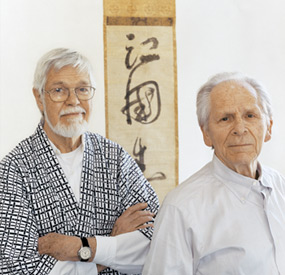
|
|
Partners in Collecting While pursuing a decades-long shared passion for calligraphy and painting, Sylvan Barnet and William Burto have assembled one of the finest collections of Japanese religious art in the West. It is, by now, a familiar story to lovers of calligraphy. Sylvan Barnet and William Burto began their collection in the 1960s, when they were newly-minted professors. They started with ceramics. While at a dealer's looking for more of the same, they chanced upon an eighteenth-century scroll by Jiun Onko. The two remember the encounter vividly. |
|
|
|
||||||||||||
|
|
 
|
|
"We had no idea that we'd be interested in calligraphy--we were there to look at ceramics--but behind his desk was this dynamic black-and-white hanging scroll. When we both saw it we looked at each other, eyes wide, mouths open--it was so powerful--it hit us immediately," said Barnet in a recent interview. They bought the scroll and began a lifelong pursuit of calligraphy and Buddhist works, which has resulted in one of the finest such collections in the West. A selection of their works will join related material from the Freer collection in the upcoming Sackler exhibition, Faith and Form: Selected Calligraphy and Painting from the Japanese Religious Tradition. The show inaugurates a developing series of exhibitions designed to combine notable themes found in the Freer collection of Japanese art with corresponding interests identified in important American collections of Japanese art, both public and private. Indefatigable and astute collectors, Barnet and Burto are also Harvard-trained scholars of English literature and theater. Retired from academia two decades ago, they've continued to gather fine works with great passion. Their collection of approximately 150 works takes in a wide range of East Asian objects, from ceramics, haniwa figures, and Buddhist implements and sculpture to a substantial grouping of works by the contemporary photographer Hiroshi Sugimoto. But the collection is dominated by calligraphy, usually rendered as a manifestation of some aspect of Japanese religious sensibility. |
|
||||||||||||
|
|
In addition, their taste for Buddhist paintings has resulted in a discrete body of rare, important works including a thirteenth-century Taizokai (Womb World) mandala--widely regarded as the earliest such mandala outside of Japanese holdings. Barnet once described their collecting process as first an instinctive sense about the rightness of a work and then the desire to "learn the sources of our pleasure." The result has been cumulative; a superb collection built by evermore informed and informative collectors. In comparison with collections with similar points of emphasis, the Barnet and Burto collection equals and probably surpasses most private and public efforts in the West during the last twenty-five years. Both men bring lifetimes of practice in wordcraft to their passion for art. In addition to an extensive list of publications related to the study of historical and critical aspects of English literature, Barnet's A Short Guide to Writing About Art, now in its seventh edition, has achieved 'classic' status. Their scholarship is wide-ranging; together they've penned several publications in the field of Japanese art and have had a hand guiding the field. According to James Ulak, chief curator of the Freer and Sackler, "Bill and Sylvan have generously read manuscripts drafted by curators and academicians, |
|
 
|
|
||||||||||||
|
|

|
|
and have not only caught some factual errors but have also offered valuable stylistic suggestions." Faith and Form will explore resonances between Freer Japanese treasures and elements of the Barnet and Burto collection, allowing close study of comparable types. More than a dozen important illuminated sutra fragments preserved in hanging scroll formats, many reflecting the collectors' taste for exquisitely prepared papers and subtle illumination, will be juxtaposed with five of the Freer's most distinguished sutras in handscroll form. The Barnet and Burto portrait of the monk Shun'oku Miyoha will be seen for the first time with the Freer portrait of his contemporary, Getsuan Shuko, offering a unique opportunity for consideration of the qualities and purposes of Zen monk portraiture. Burto says, "This is the great period for this kind of portraiture, and these are the only two portraits from this era in the U.S. Ours has a better face, I think, more interesting, but the Freer one has much more calligraphy, which is more legible." Fine mandala paintings from both collections will be on view; Barnet and Burto's rare Taizokai mandala, in gold on indigo silk, will be grouped with a pair of icons considered to be very close in date: the Freer Ryokai mandala, also in gold but on purple silk. Added to this ensemble will be the Freer's large, full colored Taizokai mandala, thought to date from the 1260s. The Freer has benefited from Barnet and Burto's keen eyes and goodwill for many years; in 1998, on the occasion of the Freer's 75th anniversary, they donated a rare handscroll fragment illustrating "Stories of the Noblemen of Heike" (Heike kindai soshi) dating from the thirteenth century. In fact, Barnet and Burto's association with the Freer goes as far back as their earliest days as collectors. Burto said recently, "Our first visit to the Freer was in 1964. We were terrifically impressed. We heard that we could go and see things in storage, so we made an appointment. Someone took us into the storeroom and let us see things for hours. Imagine! It was invaluable." Now, through Faith and Form, they are returning the favor, in effect inviting visitors of the Freer and Sackler into their own private storeroom, sharing much more of the collection that began with that black-and-white scroll decades ago. Wide eyes and open mouths are again expected. > > FAITH & FORM HOME |
|







